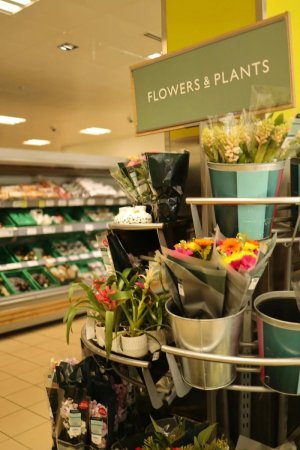Do your supermarket plants always die? Here’s what experts want you to know
By
Veronica E.
- Replies 0
If you’ve ever walked through the grocery store, spotted a lush basil plant or a cheerful peace lily, and thought, “Why not bring a little green home with my groceries?”, you’re not alone.
Supermarket plants are tempting—convenient, affordable, and often sitting right by the checkout, practically begging to be adopted.
But if your new leafy friend tends to wilt, droop, or call it quits just days after you bring it home, you’re not imagining things.
Many Americans have found themselves wondering: why are supermarket plants so hard to keep alive?
Here’s what’s really going on—and how to give your grocery store greenery a better shot at survival.

1. Treated like products, not plants
Unlike the carefully nurtured plants at local nurseries, supermarket plants are often treated more like cans of soup than living things.
They’re shipped in bulk, placed under harsh fluorescent lighting, and watered on a schedule meant for convenience—not plant health.
By the time you take one home, it may already be stressed.
2. Fast-growing and overcrowded
Herbs are especially tricky. They're often grown quickly in tight, crowded pots to look lush and full on the shelf.
But beneath the surface, the roots are tangled and the soil is exhausted—making it hard for the plant to grow once you get it home.
These herbs are usually meant for short-term use—think of them as “living produce” rather than long-term houseplants.
3. Inconsistent care
Supermarket employees are great at stocking shelves, but not all have a green thumb.
Watering routines vary, and the result can be soil that’s either waterlogged or bone dry.
By the time you buy a plant, it might already be dealing with root rot, dehydration, pests, or mold!
If you can’t resist bringing one home (and who could blame you?), here are some ways to pick a winner:
1. Repot right away
Supermarket plants are often root-bound and sitting in poor soil.
Gently remove the plant from its pot, loosen the roots, and move it to a container with fresh, high-quality potting mix.
This gives it room to breathe and grow.
2. Quarantine new arrivals
Keep new plants separate from your other houseplants for a couple of weeks.
Watch for signs of pests or disease before introducing them to the rest of your collection.
3. Ease it into its new home
Plants coming from bright lights or chilly store aisles may be in shock.
Let them adjust gradually—keep them out of direct sunlight or drafts until they’ve had time to settle.
While nurseries often offer better quality and care, there’s nothing wrong with picking up a plant during your weekly grocery trip—if you’re willing to give it some extra attention.
Think of it as a rescue mission. With a little care, many supermarket plants can recover and thrive.
Pro tip: If you’re buying herbs for cooking, consider starting with seeds or seedlings from a nursery. They’ll grow longer, produce more, and be less finicky.
Did you know that caring for houseplants can reduce stress, lift your mood, and even improve indoor air quality?
For many Americans, tending a few pots by the window brings a sense of calm and daily joy.
If you’re just getting started, choose easy-care plants and build your confidence from there!
With a little knowledge and care, even a humble supermarket plant can become a lasting part of your home.
The key is knowing what to look for, what to avoid, and how to give your new green companion a strong start.
Whether you’re a seasoned plant lover or just getting your hands dirty for the first time, every leaf and bloom is a small step toward a healthier, happier home!
Read next: An invasive insect is making its way through 19 US states—is your hometown in danger?

Have you had success—or frustration—with supermarket plants? Do you have a favorite houseplant that’s lasted for years? Share your stories, tips, and photos in the comments below. Let’s help each other grow greener, healthier homes!
Supermarket plants are tempting—convenient, affordable, and often sitting right by the checkout, practically begging to be adopted.
But if your new leafy friend tends to wilt, droop, or call it quits just days after you bring it home, you’re not imagining things.
Many Americans have found themselves wondering: why are supermarket plants so hard to keep alive?
Here’s what’s really going on—and how to give your grocery store greenery a better shot at survival.

Supermarket plants may look tempting, but without the right care, they often struggle to survive once you bring them home. Image Source: Pexels / Yelena from Pexels.
Why do supermarket plants struggle?
1. Treated like products, not plants
Unlike the carefully nurtured plants at local nurseries, supermarket plants are often treated more like cans of soup than living things.
They’re shipped in bulk, placed under harsh fluorescent lighting, and watered on a schedule meant for convenience—not plant health.
By the time you take one home, it may already be stressed.
2. Fast-growing and overcrowded
Herbs are especially tricky. They're often grown quickly in tight, crowded pots to look lush and full on the shelf.
But beneath the surface, the roots are tangled and the soil is exhausted—making it hard for the plant to grow once you get it home.
These herbs are usually meant for short-term use—think of them as “living produce” rather than long-term houseplants.
Also read: These signs will tell you if your plants are begging for more sunlight!
3. Inconsistent care
Supermarket employees are great at stocking shelves, but not all have a green thumb.
Watering routines vary, and the result can be soil that’s either waterlogged or bone dry.
By the time you buy a plant, it might already be dealing with root rot, dehydration, pests, or mold!
How to choose a healthy supermarket plant
If you can’t resist bringing one home (and who could blame you?), here are some ways to pick a winner:
- Inspect before you buy: Choose plants with perky, upright leaves. Skip any that are yellowing, drooping, or have spotted foliage. Check the soil—if it’s soggy or dry as a bone, it’s a pass.
- Look for pests or mold: Gently part the leaves and check the soil for bugs, webbing, or any fuzzy growth.
- Pick hardier varieties: Pothos, snake plants, and peace lilies tend to survive better than fragile herbs or flowering plants.
Also read: Breathe cleaner air while you sleep with these 6 magical indoor home additions
What to do when you get home
1. Repot right away
Supermarket plants are often root-bound and sitting in poor soil.
Gently remove the plant from its pot, loosen the roots, and move it to a container with fresh, high-quality potting mix.
This gives it room to breathe and grow.
2. Quarantine new arrivals
Keep new plants separate from your other houseplants for a couple of weeks.
Watch for signs of pests or disease before introducing them to the rest of your collection.
3. Ease it into its new home
Plants coming from bright lights or chilly store aisles may be in shock.
Let them adjust gradually—keep them out of direct sunlight or drafts until they’ve had time to settle.
Also read: 10 Kitchen Design Mistakes Even Professional Decorators Won't Make – Are You Guilty of These?
Should you buy plants from the supermarket at all?
While nurseries often offer better quality and care, there’s nothing wrong with picking up a plant during your weekly grocery trip—if you’re willing to give it some extra attention.
Think of it as a rescue mission. With a little care, many supermarket plants can recover and thrive.
Pro tip: If you’re buying herbs for cooking, consider starting with seeds or seedlings from a nursery. They’ll grow longer, produce more, and be less finicky.
Bonus: Houseplants and your well-being
Did you know that caring for houseplants can reduce stress, lift your mood, and even improve indoor air quality?
For many Americans, tending a few pots by the window brings a sense of calm and daily joy.
If you’re just getting started, choose easy-care plants and build your confidence from there!
With a little knowledge and care, even a humble supermarket plant can become a lasting part of your home.
The key is knowing what to look for, what to avoid, and how to give your new green companion a strong start.
Whether you’re a seasoned plant lover or just getting your hands dirty for the first time, every leaf and bloom is a small step toward a healthier, happier home!
Read next: An invasive insect is making its way through 19 US states—is your hometown in danger?
Key Takeaways
- Supermarket plants often struggle because they’re treated more like products than living things, receiving inconsistent care and harsh lighting in stores.
- Many herbs are fast-grown and overcrowded in small pots, making them hard to maintain as long-term houseplants.
- Shoppers should inspect plants carefully before buying—looking for healthy leaves, avoiding overly dry or soggy soil, and checking for pests or mold.
- To improve a plant’s chances of survival, repot it as soon as you get home, quarantine it from other plants, and help it adjust gradually to its new environment.
- While nursery plants are usually healthier, supermarket plants can still thrive with a little extra attention and care.
- Tending to houseplants can improve mood, reduce stress, and add joy to everyday life, especially for older adults.
Have you had success—or frustration—with supermarket plants? Do you have a favorite houseplant that’s lasted for years? Share your stories, tips, and photos in the comments below. Let’s help each other grow greener, healthier homes!






